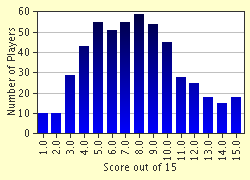Quiz Answer Key and Fun Facts
1. This 12th century English bishop is shown petting (or standing next to) a swan.
2. This female martyr holds a basket of roses and fruit, or is shown handing it to a child (or an angel). Her name means "gift of God".
3. In a famous representation in the Sistine Chapel (the "Last Judgement"), this apostle holds a knife and his own flayed skin (although he looks none the worse for wear).
4. This Benedictine saint, known as the "Apostle of Germany" is usually shown taking an axe to an oak tree.
5. This young female martyr (no one is quite sure when, or if, she actually lived) wears a crown and stands in front of a tower with three windows (or holds a miniature version of same). She also holds a sword and/or a palm branch.
6. This French Visitation nun born in 1647, is depicted kneeling before, or leaning her head against a vision of Jesus revealing His Sacred Heart. Or she may hold a flaming heart, crowned with thorns, in her hand. Although she was French, many an Irish Catholic girl has borne her name(s).
7. This young French peasant girl kneels in a grotto (now world famous) before the Virgin Mary, who is distinctively dressed all in white with a pale blue sash.
8. One of the most popular and well-loved saints (especially by children, of whom he is patron), he is usually depicted in bishop's garb holding three golden balls in one hand.
9. This pious 12th century Polish Queen is usually depicted as crowned and quite well dressed, but barefoot. Oddly, she holds a pair of shoes under her arm (no owl, though).
10. This Italian saint, born in 480 A.D., founded the order which bears his name. He is sometimes depicted sitting at table looking in dismay at a broken cup. The rule of his order was "Pray and work". His sister was a nun of the same order.
11. This New Testament saint is usually depicted either at his wedding holding a flowering almond branch (or a lily) or carrying his famous foster son holding same. Or he may be shown at work with a saw, hammer, or drill.
12. This early Christian martyr is shown holding a gridiron (on which he was roasted) and a palm branch.
13. This 7th century Irish monk is shown holding a spade or other gardening tool.
14. This very young female martyr holds a lamb (her name means lamb) and a palm branch (or a sword).
15. This 7th century French bishop (a street in Paris is named after him)holds his crozier and (incongruously) a baker's peel.
Source: Author
jouen58
This quiz was reviewed by FunTrivia editor
Lanni before going online.
Any errors found in FunTrivia content are routinely corrected through our feedback system.

